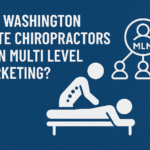Chiropractors operate in a competitive healthcare niche where trust, visibility, and patient retention are essential to long-term success. Unlike larger medical practices or hospitals, chiropractic clinics often rely heavily on local exposure and personalized patient experiences. With patients increasingly searching online and expecting professional engagement both digitally and in person, chiropractors must adopt a well-rounded marketing strategy. By combining online tools with offline outreach, they can effectively grow their patient base, increase referrals, and strengthen their presence in the community.
Understanding the Chiropractic Market
Chiropractic care is often sought for pain relief, posture correction, or wellness maintenance, but it still faces skepticism from some consumers. This makes trust and credibility key factors in attracting new patients. Unlike generalized healthcare services, chiropractic clinics typically operate in tight local markets where patients compare options based on reviews, recommendations, and visibility.
Patients looking for a chiropractor tend to value three things: convenience, expertise, and comfort. They search for practitioners near them, check reviews for reliability, and evaluate the professionalism of a clinic’s branding — both online and offline. Chiropractors also face a unique challenge: their services are often perceived as elective rather than essential, which requires strong educational outreach to convey the benefits of regular visits.
To compete effectively, chiropractors must market with clarity — explaining what they offer, why it matters, and how they stand out from others in the area.
Online Marketing Strategies
1. Local SEO Optimization
Local SEO is one of the most powerful tools chiropractors can use to reach nearby patients. It starts with claiming and optimizing a Google Business Profile, ensuring clinic information like address, hours, and services are accurate. Including keywords like “chiropractor near me” or “[city] back pain treatment” helps improve visibility in local search results.
Managing reviews is equally important. Encouraging satisfied patients to leave Google reviews builds credibility and influences new patients. Consistency across online directories (Yelp, Bing, Apple Maps) also supports search ranking and trust.
2. Chiropractic Websites That Convert
A clinic’s website acts as its digital storefront. It should load fast, be mobile-friendly, and include clear call-to-actions such as “Book an Appointment” or “Contact Us.” Including features like online scheduling, real patient testimonials, and FAQs improves user experience and builds trust.
Blog content targeting common concerns (e.g., “How to relieve neck pain”) also supports SEO and positions the chiropractor as an authority.
3. Paid Advertising (Google Ads & Meta Ads)
Paid search ads let chiropractors appear at the top of Google when patients search for specific services. Targeting keywords like “sciatica treatment [location]” ensures ads reach people ready to book.
Social media platforms like Facebook and Instagram also offer ad formats ideal for promoting wellness packages, new patient specials, or reactivation campaigns. Geo-targeting allows clinics to keep ad spend focused on their service area.
4. Social Media Marketing
Consistent social media posting helps build community presence and patient engagement. Platforms like Facebook and Instagram are ideal for educational posts (e.g., posture tips, exercise videos) and behind-the-scenes content that humanizes the clinic.
Live Q&A sessions, reels, and wellness reminders can position the chiropractor as a go-to health advisor, not just a service provider.
5. Email Marketing and Patient Follow-ups
Email marketing is an underused yet effective tool for patient retention. Automated follow-ups after appointments, birthday greetings, or reminders for re-exams keep the clinic top-of-mind.
Monthly newsletters with health tips, special offers, or clinic updates nurture loyalty and encourage rebooking. Using tools like Mailchimp or ActiveCampaign allows for segmentation and scheduling without much manual effort.
Offline Marketing Strategies
1. Community Outreach and Local Events
Building trust face-to-face remains powerful, especially in healthcare. Chiropractors often participate in community events such as health fairs, school wellness programs, and local expos. Offering free spinal screenings or short posture assessments at these events helps introduce the clinic to potential patients in a low-pressure setting.
Sponsoring local sports teams, running wellness workshops, or partnering with fitness centers also strengthens brand presence and fosters word-of-mouth awareness.
2. Referral Programs
Patient referrals are one of the most cost-effective marketing methods. Chiropractors frequently use referral programs that offer incentives like discounted adjustments, free consultations, or wellness products for referring friends and family.
Additionally, forming partnerships with other local healthcare providers—such as massage therapists, physical therapists, or personal trainers—creates cross-referral opportunities and builds a network of trust-based marketing.
3. Printed Materials and In-Office Branding
Despite the rise of digital tools, traditional print materials remain effective for reinforcing messaging. Brochures explaining treatment types, flyers promoting special offers, and branded appointment cards all contribute to the patient experience.
Inside the clinic, educational posters, patient testimonials, and wellness tip displays in waiting areas enhance professional image and can prompt questions that lead to more informed, engaged patients.
Measuring Success and ROI
To ensure marketing efforts are effective, chiropractors must track performance across both online and offline channels. For digital campaigns, tools like Google Analytics, Google Search Console, and Meta Ads Manager provide data on website traffic, ad performance, and keyword rankings. Chiropractors can monitor which blog posts bring in traffic, how many users book online, or where leads are dropping off.
For local SEO, monitoring the number of Google reviews, map pack rankings, and website click-throughs from local searches helps measure visibility in the target market.
Offline tracking can be done using referral codes, printed coupons, or simply asking new patients how they heard about the clinic. Referral source tracking allows chiropractors to adjust outreach — investing more in what works, and dropping what doesn’t.
Additionally, combining data from patient management systems with marketing tools offers a full picture: retention rates, rebooking frequency, and lifetime value of patients can all inform better decisions.
Conclusion
Chiropractors who invest in both online and offline marketing create more opportunities to attract, convert, and retain patients. A well-optimized website, active social media presence, and targeted advertising work hand in hand with grassroots efforts like community events, referrals, and in-office materials. The key is consistency — delivering a clear message across all channels and maintaining a strong local presence. With the right marketing mix, chiropractors can not only compete in their market but become the go-to provider for long-term patient care.

I’m Tangeer Mehedi, a digital marketing specialist helping chiropractors grow their practice. Through Google Ads, SEO, and targeted marketing strategies, I drive high-quality patients straight to your clinic doors. My focus is simple—turning clicks into real appointments.


